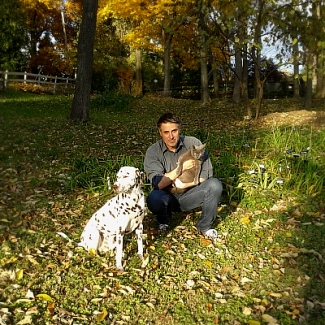

I've often been asked by customers how it came that I went to Germany and learned carpentry. Well, it just happened. I had actually planned on doing something with language later. I do have some German ancestry, having immigrated in the 19th century and learned German for four years in high school. After high school, I went to Centre College in Danville and graduated in 1990 with a Bachelor of Science in Psychology and German. I was in Germany for the first time in 1988 under the aegis of the CIEE (Council for International Educational Exchange) which enabled me to work there for several months. The opportunity to came back to Germany and see the changes after the fall of the Berlin wall 1989 came senior year as recipient of a Thomas J. Watson Fellowship.
Named after the founder of IBM, Thomas J. Watson, the fellowship pays for a year in a foreign country, giving the scholarship winner the possibility to pursue interests without any financial or achievement pressure. It was Watson's conviction that the practical experiences made in the varied countries, societies and cultures and the knowledge won would both enrich the world community and return to enrich the United States. Many Watson fellows remain in the countries they visit, and the fellows, through their experiences, often end up following different life and career paths than what they might have planned. Each year, in the entire United States, there are only 75 Watson Fellowships awarded to graduating seniors of private liberal-arts colleges.
The Watson Fellowship calls itself a Wanderjahr. In my application for the award, I proposed to research the old German tradition of the Wanderjahr. There is nothing comparable in Anglo-Saxon cultures. Craftsmen of all kinds have been going on the Wanderjahr since the 12th century. For "3 years and a day", so dictates the tradition, young craftsmen that had finished their apprenticeship were not allowed to near their home. Required to travel "abroad" to learn skills and traditions of other regions and hone their own abilities. The tradition of the Wanderjahr is still alive in Germany today and is by no means only nostalgic. The traditional Kluft or garb/uniform portrayed above is still worn by these traveling Journeymen today.
on a gracht (canal) in Amsterdam. It was challenging but fascinating to work with wood from the 17th century.

My personal version of the Wanderjahr began in the Odenwald, south of Frankfurt am Main and my hikes through East Germany and the German north brought me many interesting encounters with journeymen and master carpenters. in which I learned not only about woodworking but also about the traditional, regionally-specific building styles like half-timbered filled with clay and woven branch structure. At the end of my own year of wandering, I was invited to be a guest at a guild meeting. One Master carpenter there who had really absolved his Wanderjahre of 3 years and a day offered me an apprenticeship in his shop in Hamburg. During my time as an apprentice, I would spend part of the time working in the shop and part of the time at trade school, learning skill-specific subjects.
This special apprenticeship system in Germany, called "Dual System", is unique with the combination of learning practical knowledge of experienced masters and theoretical knowledge of your craft and the material you work with. Apprenticeship in Germany is more than learning by doing, and that's the reason why the American handyman system is unknown in Germany. Germans trust experienced and trained craftsmen who've learned the foundation of their craft over 3 years' training. In 1993, the apprenticeship was complete, and I went on to work as carpenter and fine-woodworker in Germany and spent 3 years in Amsterdam on a large restoration project, too.

2004, I was called to the Spanish island of Mallorca to restore the woodwork of a large, traditional finca or ranch. It was the kind of assignment a craftsman dreams of: I had the mandate to design, plan, renovate the entire old wood - both exterior and interior. This included not only the restoration of the wood ceilings, beams and floors, but also installation of new floors and construction of new pergolas, installation of a new kitchen, creation of new dining room, living room and bedroom furniture in the island's traditional solid pine. I spent my last 10 years in Europe living and working for the large German community on this Mediterranean island. Mallorca is not only the vacation residence of the Spanish Royal Family, but also one of Europe's most beloved vacation destinations. Many British but mostly Germans love this beautiful island, many keeping vacation houses.
During my time in Europe I travelled whenever I got the chance. I was in Berlin, Frankfurt, Hamburg, Munich, Brussels, Amsterdam, Paris, Strasbourg, London, Edinburgh, Madrid, Barcelona, Prague, Dubrovnik, Sarajevo, Vienna, Zurich, Milan, Florence, Rome, Pompeii, Venice, Athens and Istanbul and I was able to arrange to spend 4 weeks backpacking through Egypt. Maybe the most strikingly beautiful landscape was in Norway, but my favorite city was Istanbul. I was humbled by the warm and welcoming friendliness there, and I determined to bring that back home with me.
Marc Twain is to have said: "Go away from home for 20 years and then go back". And, after 24 years, I decided that it is time to return home to Kentucky


Terms of Service
Estimates that I make for jobs are, in fact, guaranteed, total-price offers for the work in question. As special service for you, I always separate the exact cost of the material and labor in my offers, too. That's why my offers are more time intensive, and for larger projects, I will take a fee for the offer. Also, for larger projects, there is a down payment for work of 25%. Both, the offer fee and the down payment will be calculated against the final payment. Payment for material minimum 14 days before the project start or the necessary time for ordering material.